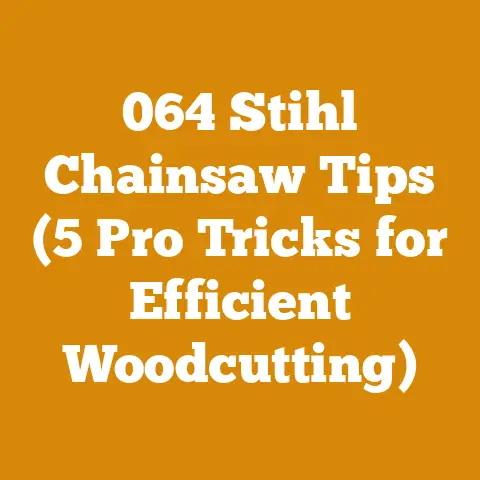Very Good Stump Grinding Tips (5Pro Tricks for New Arborists)
Imagine this: the sun is setting, casting long shadows across a yard dotted with the ghostly remnants of trees long gone. Those stumps, stubbornly clinging to the earth, are more than just eyesores; they’re obstacles, potential hazards, and a constant reminder of the work left undone. As a seasoned arborist, I’ve faced countless of these woody behemoths, and I’m here to share some of the most effective, hard-won knowledge I’ve gathered over the years.
This isn’t just another list of stump grinding tips. I’m going to pull back the curtain and reveal some “pro tricks” that will help both new arborists and seasoned veterans alike tackle those stubborn stumps with efficiency, safety, and a touch of artistry. So, grab your safety glasses, fire up your grinders, and let’s dive into the world of stump annihilation!
Very Good Stump Grinding Tips: 5 Pro Tricks for New Arborists
1. The Pre-Grind Reconnaissance Mission: Knowing Your Enemy
Before you even think about firing up that stump grinder, you need to conduct a thorough reconnaissance mission. This isn’t just about eyeballing the stump; it’s about understanding its secrets, its weaknesses, and the potential hazards lurking beneath the surface. Think of it as your pre-battle briefing.
- Size and Species Matter: The diameter of the stump is an obvious consideration, but the species of the tree is just as crucial. A pine stump will grind much differently than an oak stump. Pine is softer and resinous, while oak is dense and resistant. Knowing the species will inform your grinding strategy and the type of teeth you’ll want on your grinder. For instance, grinding seasoned oak requires sharp, aggressive teeth, while softer wood can be handled with less specialized blades.
- Underground Obstacles: The Silent Killers: This is where things get interesting, and potentially dangerous. Buried rocks, utility lines, irrigation systems, and even old foundations can wreak havoc on your grinder and your body. Always, always call your local utility companies to mark underground lines. It’s a free service, and it could save your life. I once skipped this step on a rush job and nearly severed a buried gas line. Trust me, the consequences aren’t worth the few minutes you think you’re saving.
- Root System Assessment: How extensive is the root system? Are there large lateral roots extending far beyond the visible stump? Understanding the root structure will help you determine how much grinding you’ll need to do to prevent regrowth and ensure the area is suitable for future landscaping.
- Surrounding Environment: Is the stump located near a building, a fence, or other sensitive structures? You’ll need to take precautions to protect these structures from flying debris. I’ve seen countless patios and siding damaged by carelessly flung wood chips. Proper planning and shielding can prevent costly repairs.
- Soil Type: Is the soil sandy, clay, or rocky? This will affect the amount of dust generated during grinding and the stability of the grinder. Sandy soil can create a dust storm, while clay soil can become slippery when wet.
Data Point: According to the Tree Care Industry Association (TCIA), underground utility strikes are a leading cause of accidents in the tree care industry. Always call before you dig!
Personal Story: I once had a job grinding a massive oak stump in a backyard. Everything seemed straightforward until I started grinding and hit something hard. Turns out, the stump was growing around an old concrete birdbath base that had been buried years ago. It took me an extra hour and a few broken teeth to remove it, but it was a valuable lesson in the importance of thorough pre-grind inspections.
Actionable Takeaway: Create a pre-grind checklist that includes all of the above considerations. This will help you avoid costly mistakes and ensure a safe and efficient grinding process.
2. Mastering the Art of the Grind: Techniques for Efficiency and Safety
Now that you’ve assessed the situation, it’s time to get down to business. But stump grinding isn’t just about brute force; it’s about technique, finesse, and a deep understanding of how your machine works.
- The Swing Method: This is the most common grinding technique, and it involves swinging the grinder head back and forth across the stump, gradually lowering it as you go. The key is to maintain a consistent speed and depth, avoiding jerky movements that can damage the grinder or cause it to kick back.
- The Plunge Cut Method: This technique is useful for breaking down large stumps or for reaching deep into the ground. It involves plunging the grinder head straight down into the stump, then moving it side to side to create a wider cut. Be careful when using this method, as it can generate a lot of heat and dust.
- The Edge-and-Fill Method: This is my preferred method for achieving a smooth, level finish. Start by grinding around the edges of the stump, then gradually fill in the center. This helps to prevent the grinder from bogging down and creates a more uniform surface.
- Depth Control: How deep should you grind? This depends on the intended use of the area. If you’re planning to plant grass, you’ll need to grind at least 6 inches below the surface. If you’re planning to build a structure, you may need to grind even deeper. Always consult with a landscape architect or engineer to determine the appropriate depth.
- Chip Management: Stump grinders generate a massive amount of wood chips. It’s important to manage these chips effectively to prevent them from becoming a hazard or a nuisance. Use a tarp or a wheelbarrow to collect the chips and dispose of them properly. I like to use the chips as mulch in my garden, but you can also donate them to a local community garden or compost them.
Data Point: A well-maintained stump grinder can remove a 24-inch diameter stump in approximately 1-2 hours, depending on the species of wood and the depth of grinding required.
Personal Story: I remember one particularly challenging job where I had to grind a massive redwood stump that was located right next to a swimming pool. The homeowner was concerned about the wood chips contaminating the pool water. I ended up building a makeshift barrier out of plywood and tarps to contain the chips. It was a lot of extra work, but it kept the pool clean and the homeowner happy.
Actionable Takeaway: Practice different grinding techniques on scrap wood to develop your skills and find the methods that work best for you. Always wear appropriate safety gear, including eye protection, hearing protection, and gloves.
3. The Power of Sharp Teeth: Maintaining Your Grinder for Peak Performance
Your stump grinder is only as good as its teeth. Dull or damaged teeth will not only slow you down, but they can also damage the grinder and increase the risk of kickback. Regular maintenance is essential for ensuring peak performance and prolonging the life of your machine.
- Sharpening Techniques: There are several ways to sharpen stump grinder teeth, including using a hand file, a grinder, or a specialized sharpening machine. The best method depends on the type of teeth and the level of sharpness required. I prefer to use a diamond-coated hand file for maintaining the edges of my teeth on a daily basis. For more extensive sharpening, I use a bench grinder with a specialized grinding wheel.
- Tooth Replacement: Even with regular sharpening, stump grinder teeth will eventually wear out and need to be replaced. Replace teeth when they are significantly worn, chipped, or cracked. Always use the correct type of teeth for your grinder model, and follow the manufacturer’s instructions for installation.
- Regular Inspections: Inspect your grinder teeth regularly for damage or wear. Look for cracks, chips, or excessive wear on the cutting edges. Replace any damaged teeth immediately.
- Greasing and Lubrication: Keep your grinder properly greased and lubricated to prevent wear and tear. Follow the manufacturer’s recommendations for lubrication intervals and types of grease.
- Belt Tension: Check the belt tension regularly to ensure that the grinder is operating at peak efficiency. Loose belts can slip and cause the grinder to overheat.
Data Point: Properly sharpened stump grinder teeth can increase grinding efficiency by up to 30%.
Personal Story: I once ignored a slightly dull set of teeth on a big job to save time. Big mistake. The grinder vibrated so violently it loosened a bolt on the engine mount, causing significant damage. The cost of the repair far outweighed the time I thought I was saving by not sharpening the teeth. Lesson learned: sharp teeth are an investment, not an expense.
Actionable Takeaway: Develop a regular maintenance schedule for your stump grinder, including sharpening, tooth replacement, greasing, and belt tension checks. This will help you keep your machine running smoothly and prevent costly repairs.
4. Safety First, Always: Protecting Yourself and Others
Stump grinding is a dangerous job, and safety should always be your top priority. Wear appropriate safety gear, follow safe operating procedures, and be aware of your surroundings.
- Personal Protective Equipment (PPE): Always wear eye protection, hearing protection, gloves, and sturdy footwear when operating a stump grinder. A full-face shield is recommended for added protection from flying debris.
- Safe Operating Procedures: Follow the manufacturer’s instructions for operating your stump grinder. Never operate the grinder under the influence of drugs or alcohol. Keep bystanders at a safe distance from the grinder.
- Emergency Preparedness: Have a first-aid kit on hand and know how to use it. Keep a cell phone nearby in case of emergencies. Know the location of the nearest hospital or urgent care facility.
- Kickback Prevention: Kickback is a common hazard when operating a stump grinder. To prevent kickback, always keep a firm grip on the grinder handles and avoid grinding at an angle. Never force the grinder into the stump.
- Dust Control: Stump grinding can generate a lot of dust, which can be harmful to your lungs. Wear a dust mask or respirator to protect yourself from inhaling dust particles. Wetting down the stump and surrounding area can also help to reduce dust.
Data Point: According to the Occupational Safety and Health Administration (OSHA), eye injuries are a common hazard in the tree care industry. Always wear appropriate eye protection.
Personal Story: I once witnessed a near-miss when a fellow arborist was grinding a stump and a piece of wood flew out and struck him in the face. Luckily, he was wearing a full-face shield, which prevented serious injury. This incident reinforced the importance of wearing appropriate PPE at all times.
Actionable Takeaway: Develop a safety plan for every stump grinding job, including a list of potential hazards, a description of safe operating procedures, and an emergency contact list. Review the safety plan with your crew before starting work.
5. The Art of the Cleanup: Leaving a Lasting Impression
The job isn’t done until the cleanup is complete. A thorough cleanup not only leaves a positive impression on your clients, but it also helps to prevent erosion and promote healthy plant growth.
- Chip Removal: Remove all wood chips from the work area. Use a shovel, a rake, or a wheelbarrow to collect the chips and dispose of them properly.
- Soil Restoration: Fill the hole left by the stump with topsoil and compact it firmly. This will help to prevent erosion and create a suitable planting surface.
- Seeding or Planting: Seed the area with grass seed or plant a new tree or shrub. Choose plants that are well-suited to the soil and climate.
- Mulching: Apply a layer of mulch around the newly planted area to help retain moisture and suppress weeds.
- Client Communication: Communicate with your clients throughout the cleanup process. Let them know what you’re doing and why. Answer any questions they may have.
Data Point: A well-maintained lawn can increase property value by up to 15%.
Personal Story: I once had a client who was so impressed with my cleanup efforts that she referred me to several of her neighbors. A little extra effort during the cleanup can go a long way in building your reputation and growing your business.
Actionable Takeaway: Develop a standard cleanup procedure for every stump grinding job. This will ensure that you leave a lasting positive impression on your clients.
Bonus Tip: Consider offering additional services, such as tree planting or landscaping, to further enhance the value of your services.
Beyond the Basics: Advanced Techniques and Considerations
While the five pro tricks above will give you a solid foundation for stump grinding success, there are always more advanced techniques and considerations to explore.
- Grinding in Confined Spaces: Working in tight spaces requires extra caution and specialized equipment. Smaller, more maneuverable grinders are ideal for these situations. Always be aware of your surroundings and take extra precautions to protect nearby structures.
- Grinding on Slopes: Grinding on slopes can be challenging due to the uneven terrain and the risk of the grinder tipping over. Use extra caution and consider using stabilizing equipment, such as outriggers or winches.
- Dealing with Large Stumps: Extremely large stumps may require multiple grinding sessions or the use of specialized equipment, such as a hydraulic excavator with a stump grinding attachment.
- Environmental Considerations: Be mindful of the environmental impact of stump grinding. Avoid grinding near waterways or sensitive habitats. Use biodegradable lubricants and fuels whenever possible.
Unique Insight: The wood chip byproduct of stump grinding can be a valuable resource. Consider partnering with local farms or community gardens to donate your wood chips for use as mulch or compost. This can help to reduce waste and promote sustainable practices.
Case Study: I once worked on a project where we were removing a large number of trees from a forested area to make way for a new housing development. Instead of simply discarding the wood chips from the stump grinding, we partnered with a local farmer to use them as mulch in his fields. This not only reduced waste, but it also helped to improve the soil quality and increase crop yields.
Conclusion: From Novice to Pro – Embracing the Journey
Stump grinding is a challenging but rewarding profession. By mastering the techniques, prioritizing safety, and continuously learning, you can transform from a novice into a seasoned pro. Remember to always approach each job with a combination of skill, knowledge, and respect for the environment.
The tips I’ve shared here are just a starting point. The real learning comes from experience, from the countless hours spent wrestling with stubborn stumps, and from the willingness to adapt and improve your techniques. So, get out there, hone your skills, and leave your mark on the world, one stump at a time. After all, every conquered stump is a testament to your dedication and expertise. And who knows, maybe one day you’ll be the one sharing your pro tricks with the next generation of arborists.






